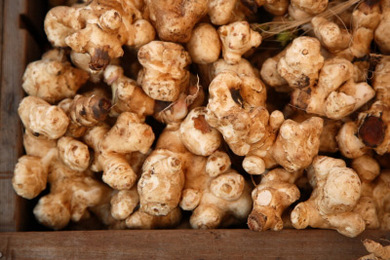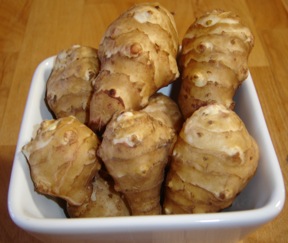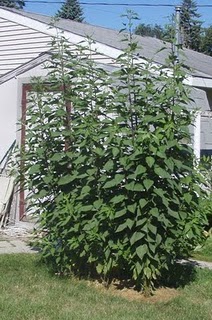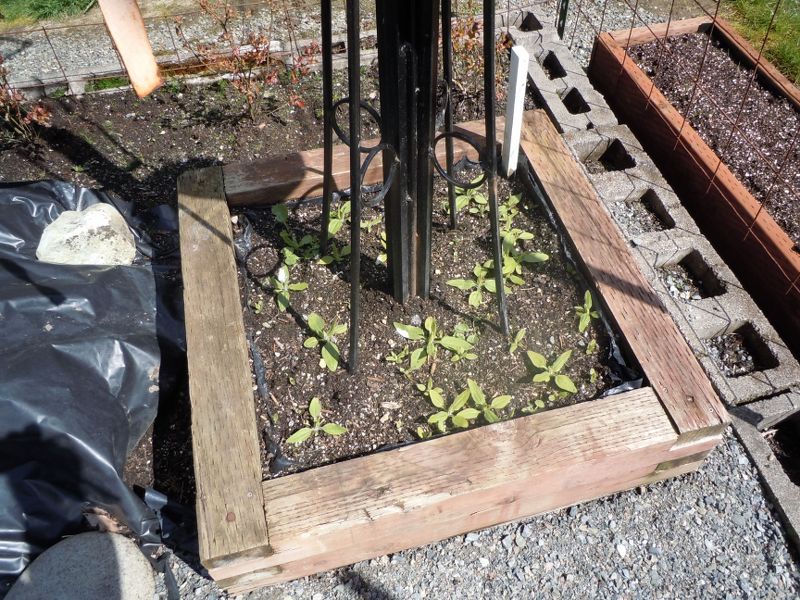Search
Latest topics
» Cooked worms?by KiwiSFGnewbie Yesterday at 11:18 pm
» What are you eating from your garden today?
by cyclonegardener Yesterday at 10:35 pm
» N & C Midwest: Nov. Dec. 2024
by OhioGardener Yesterday at 5:06 pm
» Tree roots, yeeessss.....
by KiwiSFGnewbie Yesterday at 12:17 am
» New SFG gardener in Auckland
by KiwiSFGnewbie 11/16/2024, 11:25 pm
» Kiwi's SFG Adventure
by KiwiSFGnewbie 11/12/2024, 7:10 pm
» Thanksgiving Cactus
by OhioGardener 11/12/2024, 5:40 pm
» Happy Birthday!!
by sanderson 11/11/2024, 11:57 am
» Need Garden Layout Feedback
by markqz 11/9/2024, 9:16 pm
» Thai Basil
by Scorpio Rising 11/8/2024, 8:52 pm
» How best to keep a fallow SFG bed
by KiwiSFGnewbie 11/8/2024, 8:11 pm
» Preserving A Bumper Tomato Harvest with Freezing vs Canning
by plantoid 11/7/2024, 11:36 am
» Mark's first SFG
by sanderson 11/6/2024, 11:51 pm
» What Have You Picked From Your Garden Today
by OhioGardener 11/5/2024, 2:29 pm
» Greetings from Southeastern Wisconsin
by sanderson 11/5/2024, 2:01 pm
» Spinning Compost Bin-need some ideas
by rtfm 11/2/2024, 7:49 pm
» Growing fruit trees in Auckland
by OhioGardener 10/31/2024, 4:23 pm
» Vermiculite -- shipping sale through 10/31/2024
by markqz 10/30/2024, 2:27 pm
» N & C Midwest: October 2024
by Scorpio Rising 10/30/2024, 10:38 am
» Old Mulch and Closing Beds for Winter
by sanderson 10/26/2024, 11:00 pm
» Ohio Gardener's Greenhouse
by OhioGardener 10/25/2024, 7:17 pm
» Hello from Land of Umpqua, Oregon Zone 8b
by sanderson 10/25/2024, 3:14 pm
» Hello everyone!
by SFGHQSTAFF 10/24/2024, 3:22 pm
» Senior Gardeners
by sanderson 10/23/2024, 6:09 pm
» Hello from South Florida
by markqz 10/23/2024, 10:30 am
» Confirm what this is
by sanderson 10/11/2024, 2:51 pm
» Harlequin Beetles?
by sanderson 10/7/2024, 3:08 pm
» N & C Midwest: September 2024
by OhioGardener 9/30/2024, 4:13 pm
» The SFG Journey-Biowash
by OhioGardener 9/29/2024, 8:33 am
» Fall is For Garlic Planting
by Scorpio Rising 9/28/2024, 12:19 am
Google
Friday's Rookie Post III...Sunroots!
+13
newstart
shannon1
Nonna.PapaVino
Smartchick
Miss M
Lavender Debs
FarmerValerie
dizzygardener
camprn
GlassHen
boffer
BackyardBirdGardner
middlemamma
17 posters
Page 1 of 2
Page 1 of 2 • 1, 2 
 Friday's Rookie Post III...Sunroots!
Friday's Rookie Post III...Sunroots!
Known by many names: Jerusalem Artichoke, Sunchokes, Sunroots or Earth Apples are a member of the Sunflower family (Helianthus tuberosus) native to North America and grown for its edible tubers.
Jerusalem is from the Italian word "girasole" meaning turning toward the sun, or sunflower.
Above the ground the plants grow tall and similar to a sunflower, while below the ground the tubers grow gnarly and uneven. Resembling gingeroot.






The edible tubers are somewhat potato-like, but the carbohydrate present is inulin rather than starch. When consumed the inulin is converted in the digestive tract to fructose rather than glucose, which can be tolerated by diabetics.
They are reported to taste similar to water chestnuts by some and potato-ish by others. They are claimed to have a nut-like flavor by still others and can be sliced sliced raw into salads, sautéed in a little butter, roasted, mashed and on and on and on.
Washington State is one of the leading American commercial producing areas for sunchokes...which is funny because I have NEVER seen one in the grocery store!!! (I border Washington here in Idaho).
They don't seem to have regular susceptibility to any disease or pest.
Growing sunchokes appears to be very easy. They will not spread beyond their planting but they are hard to get rid of because you must get every single little tuber to be sure they won't grow back. They will become unruly if not managed. They grow best in the northern 2/3rd of the US and they are perennial and hardy from zone 4-8 by most sources and to zone 9 by a few sources. They can grow from 7 to 10 feet tall and require full sun exposure.
They nearly demand a permanent place in your garden because once introduced they are very hard to get rid of completely. You can leave them in the ground right through fall, winter in some places. You can dig them as needed, the tubers are hardy to 50 degrees. It is reported that Jerusalem artichokes are at their sweetest from fall through winter. Indeed, like most root vegetables, they are much improved in flavor by at least one heavy frost.
Plant as early in spring as the soil is workable, or you can plant them in the fall or winter and wait for a full year to harvest your crop.To plant them you cut up a tuber into a few pieces, each piece having at least one, but preferably two eyes on it. Do not let the pieces dry out like some do a potato before planting. Plant the pieces 4-6 inches down. When small go ahead and weed around them but not too deeply. After they become more established the weeds will not be able to compete with them and you can let the area go to weed if you wish. They will also do very well in raised beds. Sunchokes will thrive is very poor conditions but must have full sun. Water well but occasionally, perhaps once a week, and twice a week in summer.
If you want to harvest a few early tubers you can, but they are likely to be small. In the fall or autumn as late as possible but still before the ground is to frozen to dig harvest your crop. Some folks will leave them in the ground all winter long and not harvest until the spring thaw occurs. Some people swear they taste even better after fully overwintering.
To harvest you will have to dig pretty extensively both vertically and horizontally to make sure you got all your crop. Take care not to dig harshly or you will damage the tubers. That's why it is super helpful to have loose and friable soil. (Can you say Mel's Mix?!) When you are pretty sure that you have gotten them all from an individual plant leave a small piece in the ground and cover the hole. Now you will have planted for the next year.
THEY SOUND AWESOME DON'T THEY!!!!
I compiled all of this info from various sources by simply googling sunchoke and it's other aliases. There is tons more info out there on them. They are very expensive to buy from the seed catalogs, Johnny's wants 19.50 for a pound of them. Everything i read said that a grocery store one will work just fine. They are really common in Europe as a cooked vegetable, sources said, but very little known here in the states. I have never had one...but you can bet I will be planting some here soon if I can find them or in the fall.
Now for some recipes!!
PICKLES (from about.com)
Sunchokes are not only good for you, they also make great pickles. Plan ahead to make these at least a week before consuming.
Prep: 30 min
Cook time: 5 min
2-1/2 pounds Jerusalem artichokes
2 Tablespoons lemon juice
1 pound cauliflower (optional)
Pickling salt
4 cups cider vinegar
1 cup white vinegar
1 cup water
2 cups sugar
1-1/2 teaspoons celery seeds
1-1/2 teaspoons turmeric
2 teaspoons mustard seeds
1-1/2 teaspoons dry mustard
1 large green pepper
1 large red pepper
1 large onion
Peel and cut the Jerusalem artichokes
into 1/2-inch chunks and drop into water acidulated with lemon juice.
Cut up the head of cauliflower, break flowerets into 1/2-inch pieces,
and peel and cut the stems into 1/2-inch cubes. Crisp the vegetables in a
brine solution made this way: Cover the chokes and cauliflower with
water to see how much water you need, then drain the vegetables, saving
the water, and mix into it 1/3 cup pickling salt per quart. Place the
vegetables in this brine and soak for 24 hours.
Combine the vinegars, water, sugar, celery seeds, turmeric, mustard seeds, and dry mustard in a stainless steel or enameled saucepan and bring to a
boil. Stir to dissolve sugar, reduce heat, and let simmer for 3
minutes. Remove from heat.
While the brine is simmering, coarsely chop the peppers and onion. Drain
the chokes and cauliflower, rinse them well to remove salt, and drain
again. Combine chokes, cauliflower, peppers, and onion and pack into
clean hot jars, following manufacturer's directions. Ladle in hot brine,
a bit at a time, making sure it runs through the vegetables. (Putting a
long, sterilized skewer in the jar and moving it around helps the syrup
flow through the vegetables.) Fill to 1/8 inch of the jar top, seal,
and process in a hot water bath for 10 minutes. Set pickles in a cool place for at least 1 week before serving. Yield: 3 quarts
Latkes (from about.com)
Jerusalem artichokes) are chopped and mixed with rice flour, flaxseed, and herbs, then fried into latkes. This is a delicious and healthful vegetarian side dish which may be served hot or cold.
Prep: 15 min
Cook time: 30 min
1 cup lukewarm soy milk, vegetable stock, or water
1 Tablespoon olive oil
1 Tablespoon active dry yeast
4 cloves garlic, peeled
1 teaspoon sweet paprika
1 teaspoon dried marjoram, finely crumbled
1/2 teaspoon Vege-Sal or 1/4 teaspoon salt, or to taste
1/2 teaspoon freshly ground white or black pepper (1/4 teaspoon peppercorns), or to taste
1 cup sunchokes (Jerusalem artichokes), coarsely chopped
1-1/2 teaspoons lecithin granules
1 cup plus 2 Tablespoons sweet brown rice flour or 1-1/4 pounds any other whole-grain flour
1/2 cup arrowroot or kudzu
2-1/2 Tablespoons freshly ground flaxseeds (1 Tablespoon seeds)
In a blender, combine the lukewarm soy milk, olive oil, yeast, garlic, paprika, marjoram, Vege-Sal, and pepper, and process until smooth.
Add the Jerusalem artichokes and lecithin and process until the Jerusalem artichokes are very finely chopped.
Mix the flour, arrowroot, and ground flaxseeds together in a large bowl. Stir the wet ingredients into the dry ingredients and mix well. Divide the dough into 12 pieces and shape each piece into a 1/2-inch-thick disk. Cover the latkes with a damp towel and let them rise ina a warm place (80 to 85 degrees F) for 30 to 60 minutes.
Cook the latkes on both sides on a hot, oiled griddle or frying pan until they are browned, 5 to 10 minutes on each side. (Peanut oil, which tolerates heating best, is the first choice, although you may also bake the latkes for 20 minutes on an oiled cookie sheet in a preheated 350-degree F oven.) Serve Sunchoke Latkes hot or cold. Yield: 6 servings, 12 latkes
Roasted Cauliflower, Brussel Sprouts and Sunchokes (from Food Networn.com)
1 head cauliflower, cut into bite-size florets
1 pint brussel sprouts, cut in 1/2
1/2 pound Jerusalem artichokes, scrubbed and diced to 1-inch
Extra-virgin olive oil
Salt
1/4 cup chopped chives
Preheat the oven to 375 degrees F.
In a large bowl, combine all the vegetables, coat with olive oil and season generously with salt.
Spread the vegetables on a sheet tray in an even layer, don't pile them up. The vegetables don't need to be spread out but they need to be pretty much in a single even layer. If this is not the case, use 2 trays.
Put the vegetables in the preheated oven. 15 minutes into the cooking process, stir the vegetables so they have the chance to brown all over, and rotate the tray to insure even cooking. Repeat this process after another 15 minutes. Roast the vegetables for an additional 15 to 20 minutes, or until the vegetables are roasty brown and should smell almost like popcorn. Check for doneness. This means taste some! If they aren't very roasty brown, let them go for another few minutes until they are. Season with salt, if needed. Transfer to a serving dish, garnish with chives and serve immediately.
Cream of Jerusalem Artichoke Soup (from allrecipes.com)1/4 cup butter
2 onions, minced
1 pound Jerusalem artichokes, roughly chopped
2 potatoes, peeled and cubed
1 tablespoon brandy
1 tablespoon all-purpose flour
3 cups chicken broth
3/4 cup heavy whipping cream
salt and pepper to taste
1/4 cup chopped fresh parsley, for garnish
Melt the butter in a large pan over medium heat until foamy. Add the onions, artichokes and potatoes and cook, covered, over low heat for 10 minutes. Uncover and cook for and additional 8 minutes. Stir in the brandy, and flour, and cook for 1 minute. Gradually stir in about 2 cups of the stock, stirring continuously, until the soup boils and thickens. Simmer for a further 5 minutes. Transfer to a food processor and puree until smooth, adding more stock if needed.
Return to the pan, add the cream and season well with salt and freshly ground black pepper, then reheat. Sprinkle with the chopped parsley, to serve.
ENJOY!!!!
Sunchoke Nutritional Value Guide: (Raw)
Quantity - 1 Cup
Energy - 115 Calories
Carbohydrates - 26 (grams)
Protein - 3 (grams)
Cholesterol - 0 (milligrams)
Weight - 150 (grams)
Fat - 0 (grams)
Saturated Fat 0 (grams)
Jerusalem is from the Italian word "girasole" meaning turning toward the sun, or sunflower.
Above the ground the plants grow tall and similar to a sunflower, while below the ground the tubers grow gnarly and uneven. Resembling gingeroot.






The edible tubers are somewhat potato-like, but the carbohydrate present is inulin rather than starch. When consumed the inulin is converted in the digestive tract to fructose rather than glucose, which can be tolerated by diabetics.
They are reported to taste similar to water chestnuts by some and potato-ish by others. They are claimed to have a nut-like flavor by still others and can be sliced sliced raw into salads, sautéed in a little butter, roasted, mashed and on and on and on.
Washington State is one of the leading American commercial producing areas for sunchokes...which is funny because I have NEVER seen one in the grocery store!!! (I border Washington here in Idaho).
They don't seem to have regular susceptibility to any disease or pest.
Growing sunchokes appears to be very easy. They will not spread beyond their planting but they are hard to get rid of because you must get every single little tuber to be sure they won't grow back. They will become unruly if not managed. They grow best in the northern 2/3rd of the US and they are perennial and hardy from zone 4-8 by most sources and to zone 9 by a few sources. They can grow from 7 to 10 feet tall and require full sun exposure.
They nearly demand a permanent place in your garden because once introduced they are very hard to get rid of completely. You can leave them in the ground right through fall, winter in some places. You can dig them as needed, the tubers are hardy to 50 degrees. It is reported that Jerusalem artichokes are at their sweetest from fall through winter. Indeed, like most root vegetables, they are much improved in flavor by at least one heavy frost.
Plant as early in spring as the soil is workable, or you can plant them in the fall or winter and wait for a full year to harvest your crop.To plant them you cut up a tuber into a few pieces, each piece having at least one, but preferably two eyes on it. Do not let the pieces dry out like some do a potato before planting. Plant the pieces 4-6 inches down. When small go ahead and weed around them but not too deeply. After they become more established the weeds will not be able to compete with them and you can let the area go to weed if you wish. They will also do very well in raised beds. Sunchokes will thrive is very poor conditions but must have full sun. Water well but occasionally, perhaps once a week, and twice a week in summer.
If you want to harvest a few early tubers you can, but they are likely to be small. In the fall or autumn as late as possible but still before the ground is to frozen to dig harvest your crop. Some folks will leave them in the ground all winter long and not harvest until the spring thaw occurs. Some people swear they taste even better after fully overwintering.
To harvest you will have to dig pretty extensively both vertically and horizontally to make sure you got all your crop. Take care not to dig harshly or you will damage the tubers. That's why it is super helpful to have loose and friable soil. (Can you say Mel's Mix?!) When you are pretty sure that you have gotten them all from an individual plant leave a small piece in the ground and cover the hole. Now you will have planted for the next year.
It is said that you can expect from 2 to 5 pounds of tubers from each plant. Under ideal conditions--31° to 32° F. and 90% to 95% humidity--sunchokes can be kept for months; but in the refrigerator within days they go soft and become unattractive for any fresh use where their crispness is wanted. So use a few right away for any fresh use you want, such as salads, and cook up the rest for freezing.
THEY SOUND AWESOME DON'T THEY!!!!
I compiled all of this info from various sources by simply googling sunchoke and it's other aliases. There is tons more info out there on them. They are very expensive to buy from the seed catalogs, Johnny's wants 19.50 for a pound of them. Everything i read said that a grocery store one will work just fine. They are really common in Europe as a cooked vegetable, sources said, but very little known here in the states. I have never had one...but you can bet I will be planting some here soon if I can find them or in the fall.
Now for some recipes!!
PICKLES (from about.com)
Sunchokes are not only good for you, they also make great pickles. Plan ahead to make these at least a week before consuming.
Prep: 30 min
Cook time: 5 min
2-1/2 pounds Jerusalem artichokes
2 Tablespoons lemon juice
1 pound cauliflower (optional)
Pickling salt
4 cups cider vinegar
1 cup white vinegar
1 cup water
2 cups sugar
1-1/2 teaspoons celery seeds
1-1/2 teaspoons turmeric
2 teaspoons mustard seeds
1-1/2 teaspoons dry mustard
1 large green pepper
1 large red pepper
1 large onion
Peel and cut the Jerusalem artichokes
into 1/2-inch chunks and drop into water acidulated with lemon juice.
Cut up the head of cauliflower, break flowerets into 1/2-inch pieces,
and peel and cut the stems into 1/2-inch cubes. Crisp the vegetables in a
brine solution made this way: Cover the chokes and cauliflower with
water to see how much water you need, then drain the vegetables, saving
the water, and mix into it 1/3 cup pickling salt per quart. Place the
vegetables in this brine and soak for 24 hours.
Combine the vinegars, water, sugar, celery seeds, turmeric, mustard seeds, and dry mustard in a stainless steel or enameled saucepan and bring to a
boil. Stir to dissolve sugar, reduce heat, and let simmer for 3
minutes. Remove from heat.
While the brine is simmering, coarsely chop the peppers and onion. Drain
the chokes and cauliflower, rinse them well to remove salt, and drain
again. Combine chokes, cauliflower, peppers, and onion and pack into
clean hot jars, following manufacturer's directions. Ladle in hot brine,
a bit at a time, making sure it runs through the vegetables. (Putting a
long, sterilized skewer in the jar and moving it around helps the syrup
flow through the vegetables.) Fill to 1/8 inch of the jar top, seal,
and process in a hot water bath for 10 minutes. Set pickles in a cool place for at least 1 week before serving. Yield: 3 quarts
Latkes (from about.com)
Jerusalem artichokes) are chopped and mixed with rice flour, flaxseed, and herbs, then fried into latkes. This is a delicious and healthful vegetarian side dish which may be served hot or cold.
Prep: 15 min
Cook time: 30 min
1 cup lukewarm soy milk, vegetable stock, or water
1 Tablespoon olive oil
1 Tablespoon active dry yeast
4 cloves garlic, peeled
1 teaspoon sweet paprika
1 teaspoon dried marjoram, finely crumbled
1/2 teaspoon Vege-Sal or 1/4 teaspoon salt, or to taste
1/2 teaspoon freshly ground white or black pepper (1/4 teaspoon peppercorns), or to taste
1 cup sunchokes (Jerusalem artichokes), coarsely chopped
1-1/2 teaspoons lecithin granules
1 cup plus 2 Tablespoons sweet brown rice flour or 1-1/4 pounds any other whole-grain flour
1/2 cup arrowroot or kudzu
2-1/2 Tablespoons freshly ground flaxseeds (1 Tablespoon seeds)
In a blender, combine the lukewarm soy milk, olive oil, yeast, garlic, paprika, marjoram, Vege-Sal, and pepper, and process until smooth.
Add the Jerusalem artichokes and lecithin and process until the Jerusalem artichokes are very finely chopped.
Mix the flour, arrowroot, and ground flaxseeds together in a large bowl. Stir the wet ingredients into the dry ingredients and mix well. Divide the dough into 12 pieces and shape each piece into a 1/2-inch-thick disk. Cover the latkes with a damp towel and let them rise ina a warm place (80 to 85 degrees F) for 30 to 60 minutes.
Cook the latkes on both sides on a hot, oiled griddle or frying pan until they are browned, 5 to 10 minutes on each side. (Peanut oil, which tolerates heating best, is the first choice, although you may also bake the latkes for 20 minutes on an oiled cookie sheet in a preheated 350-degree F oven.) Serve Sunchoke Latkes hot or cold. Yield: 6 servings, 12 latkes
Roasted Cauliflower, Brussel Sprouts and Sunchokes (from Food Networn.com)
1 head cauliflower, cut into bite-size florets
1 pint brussel sprouts, cut in 1/2
1/2 pound Jerusalem artichokes, scrubbed and diced to 1-inch
Extra-virgin olive oil
Salt
1/4 cup chopped chives
Preheat the oven to 375 degrees F.
In a large bowl, combine all the vegetables, coat with olive oil and season generously with salt.
Spread the vegetables on a sheet tray in an even layer, don't pile them up. The vegetables don't need to be spread out but they need to be pretty much in a single even layer. If this is not the case, use 2 trays.
Put the vegetables in the preheated oven. 15 minutes into the cooking process, stir the vegetables so they have the chance to brown all over, and rotate the tray to insure even cooking. Repeat this process after another 15 minutes. Roast the vegetables for an additional 15 to 20 minutes, or until the vegetables are roasty brown and should smell almost like popcorn. Check for doneness. This means taste some! If they aren't very roasty brown, let them go for another few minutes until they are. Season with salt, if needed. Transfer to a serving dish, garnish with chives and serve immediately.
Cream of Jerusalem Artichoke Soup (from allrecipes.com)1/4 cup butter
2 onions, minced
1 pound Jerusalem artichokes, roughly chopped
2 potatoes, peeled and cubed
1 tablespoon brandy
1 tablespoon all-purpose flour
3 cups chicken broth
3/4 cup heavy whipping cream
salt and pepper to taste
1/4 cup chopped fresh parsley, for garnish
Melt the butter in a large pan over medium heat until foamy. Add the onions, artichokes and potatoes and cook, covered, over low heat for 10 minutes. Uncover and cook for and additional 8 minutes. Stir in the brandy, and flour, and cook for 1 minute. Gradually stir in about 2 cups of the stock, stirring continuously, until the soup boils and thickens. Simmer for a further 5 minutes. Transfer to a food processor and puree until smooth, adding more stock if needed.
Return to the pan, add the cream and season well with salt and freshly ground black pepper, then reheat. Sprinkle with the chopped parsley, to serve.
ENJOY!!!!
Sunchoke Nutritional Value Guide: (Raw)
Quantity - 1 Cup
Energy - 115 Calories
Carbohydrates - 26 (grams)
Protein - 3 (grams)
Cholesterol - 0 (milligrams)
Weight - 150 (grams)
Fat - 0 (grams)
Saturated Fat 0 (grams)
Last edited by middlemamma on 4/29/2011, 2:58 am; edited 2 times in total

middlemamma-

-
 Posts : 2261
Posts : 2261
Join date : 2010-04-25
Age : 46
Location : Idaho Panhandle
 Re: Friday's Rookie Post III...Sunroots!
Re: Friday's Rookie Post III...Sunroots!
Dear God, Jennie. Great article! Where'd you find the time?

BackyardBirdGardner-
 Posts : 2710
Posts : 2710
Join date : 2010-12-25
Age : 50
Location : St. Louis, MO
 Re: Friday's Rookie Post III...Sunroots!
Re: Friday's Rookie Post III...Sunroots!
BackyardBirdGardner wrote:Dear God, Jennie. Great article! Where'd you find the time?
+1
When you want something done, give the task to a busy person!
 Re: Friday's Rookie Post III...Sunroots!
Re: Friday's Rookie Post III...Sunroots!
Well there had been a recent post, so I had to come up with something new!
Honestly we have been sitting here watching "Conspiracy Theory", which I have seen before, so I did it while watching the dumb box. LOL
Honestly we have been sitting here watching "Conspiracy Theory", which I have seen before, so I did it while watching the dumb box. LOL

middlemamma-

-
 Posts : 2261
Posts : 2261
Join date : 2010-04-25
Age : 46
Location : Idaho Panhandle
 Re: Friday's Rookie Post III...Sunroots!
Re: Friday's Rookie Post III...Sunroots!
boffer wrote:BackyardBirdGardner wrote:Dear God, Jennie. Great article! Where'd you find the time?
+1
When you want something done, give the task to a busy person!

middlemamma-

-
 Posts : 2261
Posts : 2261
Join date : 2010-04-25
Age : 46
Location : Idaho Panhandle
 Re: Friday's Rookie Post III...Sunroots!
Re: Friday's Rookie Post III...Sunroots!
Meh....tomato tomahto...you have kids.

BackyardBirdGardner-
 Posts : 2710
Posts : 2710
Join date : 2010-12-25
Age : 50
Location : St. Louis, MO
 Re: Friday's Rookie Post III...Sunroots!
Re: Friday's Rookie Post III...Sunroots!
That was great information. Thanks for putting it together. I had never heard of this vegetable before. Awesome!

GlassHen- Posts : 76
Join date : 2011-03-28
Age : 45
Location : Tip of the Thumb of Michigan, Zone 5B
 Re: Friday's Rookie Post III...Sunroots!
Re: Friday's Rookie Post III...Sunroots!
I will never, EVER put sunchokes in my garden again. They will have a spot away from the garden all their own.  Lovely to look at, tasty to eat, very invasive.
Lovely to look at, tasty to eat, very invasive.
 Re: Friday's Rookie Post III...Sunroots!
Re: Friday's Rookie Post III...Sunroots!
Uh, what happened to "it doesn't have to be long"? Geesh!
Great post! I'll have to try these first before I plant any in a garden. I'd hate to introduce them, decide I didn't like them, and then not be able to get rid of them. LOL

dizzygardener-
 Posts : 668
Posts : 668
Join date : 2011-01-26
Location : WNC 6b
 Re: Friday's Rookie Post III...Sunroots!
Re: Friday's Rookie Post III...Sunroots!
Ages ago we planted some on the north edge of the garden. I know why they call them chokes; 5 years later we moved the vegetable garden as we could never find all the sunchoke roots and they choked out everything else.dizzygardener wrote:

Uh, what happened to "it doesn't have to be long"? Geesh!
Great post! I'll have to try these first before I plant any in a garden. I'd hate to introduce them, decide I didn't like them, and then not be able to get rid of them. LOL
Last edited by camprn on 4/29/2011, 9:23 am; edited 1 time in total
 Re: Friday's Rookie Post III...Sunroots!
Re: Friday's Rookie Post III...Sunroots!
Attack of the killer sunchokes? LOL
Sounds like we need to put these in raised beds with bottoms lest we be overrun...
Sounds like we need to put these in raised beds with bottoms lest we be overrun...

dizzygardener-
 Posts : 668
Posts : 668
Join date : 2011-01-26
Location : WNC 6b
 Re: Friday's Rookie Post III...Sunroots!
Re: Friday's Rookie Post III...Sunroots!
GREAT JOB!!! Loved it, makes me want to try to grow some. I was thinking though they may be better off in a 4x1 box placed off to the side, or at the end of another box. Or possibly in a container you can dump and spread on a tarp, a worthwhile plant to try if you ask me!!!
 Re: Friday's Rookie Post III...Sunroots!
Re: Friday's Rookie Post III...Sunroots!
These are the new old veggie to watch. They are another small farmer self sustaining crop to get a girl through the winter in the north. For me they have always been a novelty but after reading about these on an Idaho born blog called Substance Pattern, and what that family does with these in fall, winter, spring when home grown can be difficult to find in winter, I’ve been itching to put them on my homegrown menu. For some reason (could it have been the $19.50 a pound to have it shipped across the country when they are grown here?) I didn't start any this year. I'm thinking that this fall, after we get the nuggets housed, I'll put a tub of them on the back side of the hen house to at least get them started.
Great job mm
Great job mm
 Re: Friday's Rookie Post III...Sunroots!
Re: Friday's Rookie Post III...Sunroots!
Their own Table-Top... that way, they're not even on the ground! 
My daughter just read some stuff about these to me a couple of weeks ago. Intriguing.
My daughter just read some stuff about these to me a couple of weeks ago. Intriguing.
 Re: Friday's Rookie Post III...Sunroots!
Re: Friday's Rookie Post III...Sunroots!
Interesting. I'll admit I've never heard of these. They might be cool to plant in the corner of my yard to hide the stupid green cable boxes, but alas, I shall probably have to pass on eating them. Inulin is the same substance that is found in chickory root extract (what you get in Fiber One bars and pretty much anything these days that says "double fiber") and it may be tolerated by diabetics, but it sure isn't by my digestive system. 

Smartchick- Posts : 105
Join date : 2011-02-18
Location : Omaha, NE, Zone 5
 Re: Friday's Rookie Post III...Sunroots!
Re: Friday's Rookie Post III...Sunroots!
It definetly doesn't HAVE to be long team. I just got carried away because I was interested. And the recipes were copy and paste...I just stuck them in cause that helps me visiulize what I would do with a new veggie. 

middlemamma-

-
 Posts : 2261
Posts : 2261
Join date : 2010-04-25
Age : 46
Location : Idaho Panhandle
 Re: Friday's Rookie Post III...Sunroots!
Re: Friday's Rookie Post III...Sunroots!
boffer, I know you grew some of these...how did you plant them? Did you use MM?
How deep down did they grow, did you have to dig?
If one were to make a box for them what would be a good depth?
How deep down did they grow, did you have to dig?
If one were to make a box for them what would be a good depth?

middlemamma-

-
 Posts : 2261
Posts : 2261
Join date : 2010-04-25
Age : 46
Location : Idaho Panhandle
 Re: Friday's Rookie Post III...Sunroots!
Re: Friday's Rookie Post III...Sunroots!
Last year was the first time for me. I planted them 3-4 inches deep in a 2x2x7 inch box full of MM. They would do fine in a 5 or 6 inch box. I probably planted 3-4 per sf.
When we harvested last fall we ate the biggest ones, and put the small ones back in the ground to overwinter. Here's what they look like today: like weeds!

I decided to live dangerously and also planted some along a fence line in the dirt. We'll see!
Here's what they looked like last summer before I trussed them up.

When we harvested last fall we ate the biggest ones, and put the small ones back in the ground to overwinter. Here's what they look like today: like weeds!

I decided to live dangerously and also planted some along a fence line in the dirt. We'll see!
Here's what they looked like last summer before I trussed them up.

 Sunroots, sunchokes, etc.
Sunroots, sunchokes, etc.
Great article MiddleM, truly wonderful! Thanks especially for the 'choke pickle recipe! As Smartchick noted, some folks (not all) react poorly to the carbohydrates stored as inulin, and experience flatulence. (Guess if you want to get rid of guests who have stayed too long, just serve sunchokes and kim chee.) We have raised the 'chokes for several years and find the largest tubers have developed between Christmas and end of February. After that, depending on the weather, they will be seriously thinking about sprouting and quality declines. They are, however, a tasty, easy-to-grow vegetable.

Nonna.PapaVino-
 Posts : 1435
Posts : 1435
Join date : 2011-02-07
Location : In hills west of St. Helens, OR
 Re: Friday's Rookie Post III...Sunroots!
Re: Friday's Rookie Post III...Sunroots!
What a great job! I will be planting a 2x4x?" box with a bottom next spring. I can find then in the food stores here all year. I love the way they teast crispy and nutty. I have only eaten them raw thinly sliced as a chip sub but can't wait to see how they are cooked. Middlemoma 


shannon1- Posts : 1695
Join date : 2011-04-01
Location : zone 9a St.Johns county FL
 Re: Friday's Rookie Post III...Sunroots!
Re: Friday's Rookie Post III...Sunroots!
hmm sounds great. wonder where to find them here

newstart-
 Posts : 331
Posts : 331
Join date : 2011-11-22
Age : 42
Location : houston, texas zone 9
 Re: Friday's Rookie Post III...Sunroots!
Re: Friday's Rookie Post III...Sunroots!
This is something I can still plant here. Our weather is so weird this year. Tomorrow it may get up to 62°!
Our ground isnt frozen! and my onions and garlic are sprouting! NOT good! I will look in the store today or tomorrow and if they have any I have a washtub that is already full of mix. Will plant there to see how it goes.
Our ground isnt frozen! and my onions and garlic are sprouting! NOT good! I will look in the store today or tomorrow and if they have any I have a washtub that is already full of mix. Will plant there to see how it goes.

CindiLou- Posts : 998
Join date : 2010-08-30
Age : 65
Location : South Central Iowa, Zone 5a (20mi dia area in 5b zone)rofl...
 Re: Friday's Rookie Post III...Sunroots!
Re: Friday's Rookie Post III...Sunroots!
My husband got me a great BBC show called Edible Garden by Alys Fowler and she did a bit on jerusalem artichokes and she said they're jokingly called fartichokes.  She recommends cooking them with epazote or any herb that's traditionally cooked with beans to reduce flatulence.
She recommends cooking them with epazote or any herb that's traditionally cooked with beans to reduce flatulence.
I haven't tried to grow them, but they sure look easy!
I haven't tried to grow them, but they sure look easy!
 Re: Friday's Rookie Post III...Sunroots!
Re: Friday's Rookie Post III...Sunroots!
Just following up. I harvested 1 square foot today and got 5 pounds! I usually get 3-4.

I've started using the recipe that mm posted earlier in the thread to make a creamy soup, and I really like it. I leave out the potatoes. The rest I roast, similar to mm's other recipe, with whatever is on hand from the garden: beets, carrots, potatoes, and cauliflower.
They're good for you and taste good too, but they sure are ugly suckers!

I've started using the recipe that mm posted earlier in the thread to make a creamy soup, and I really like it. I leave out the potatoes. The rest I roast, similar to mm's other recipe, with whatever is on hand from the garden: beets, carrots, potatoes, and cauliflower.
They're good for you and taste good too, but they sure are ugly suckers!
Page 1 of 2 • 1, 2 
 Similar topics
Similar topics» can you prune a pumpkin plant?
» Friday's Rookie Post II....Swiss Chard!
» Feedback: Fridays host chat with Alan
» First Time SFG and love it!
» Garden Tip - Never buy Celery Again
» Friday's Rookie Post II....Swiss Chard!
» Feedback: Fridays host chat with Alan
» First Time SFG and love it!
» Garden Tip - Never buy Celery Again
Page 1 of 2
Permissions in this forum:
You cannot reply to topics in this forum








